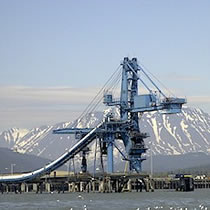
 |
|
|
February 3, 2009
Coal in SewardBy Russ MaddoxThe coal export facility was built in Seward by Veco Construction back in the eighties. It was one of Veco's largest projects to date and brought many jobs to town. I remember waiting and hoping to be selected from the casual laborers who gathered each morning to fill in for those who didn't show up, or to replace those who left the project. Jobs were scarce and this facility was welcomed for the benefit it brought our community. 
Suneel Corporation of Korea operated the facility for nearly twenty years before the Alaska Railroad and Aurora Energy (Usibelli Mine) took over. During this time period the community of Seward and its small boat harbor have thrived with the growth of the tourism trade. The expansion of the small boat harbor has effectively placed many vessels and businesses adjacent and downwind of the coal facility and its immense stockpile. The facility has never reached its projected level of operation and has struggled to keep the coal moving throughout its existence. Since its operations first began there have been issues of coal dust blowing from the site over the small boat harbor and sometimes even into town. Responses to complaints have always blamed the weather. We were always reminded that Suneel had modern controls in place and was doing everything possible to minimize fugitive dust. The entire town was very aware of the facility's controls to minimize the impacts of coal dust. We had all seen and heard of the water spraybars that were to be used to wet the coal in dry conditions. We also found comfort in knowing that there were state-of-the-art baghouses designed to vacuum the dust right off of the coal before its even exposed to the elements to minimize offsite effects. So for years the occasional dust clouds were grudgingly accepted as part of life in Seward. And besides, complaints regarding this facility or any commercial enterprise in Seward, was tantamount to treason. The expansion of the harbor and the many new businesses sited directly downwind of the facility have greatly altered this peaceful coexistence. In 2007 we had an extended dry and windy period all the way from the Usibelli Mine in Healy to the export facility in Seward. This created huge coal dustclouds which settled on vessels, and worked its way into homes and businesses alike. Reports of coal dust indoors even came from health care facilities and schools. The response from the Railroad was that this was a weather anomaly and couldn't be prevented. The Department of Environmental Conservation issued a Notice of Violation. Then the Railroad hired a consultant to analyze their controls and to make recommendations of any modifications they may deem necessary to minimize fugitive dust in the future. The reports suggested utilizing spray bars and baghouses to minimize Seward's exposure to coal dust. The Railroad's own consultant recommended utilizing controls that the residents of Seward had been led to believe had been operating all along. When we learned that our decades of exposure to coal dust could have been prevented we began the effort to get all of the controls up and running. The Railroad's response baffles me to this day. They cannot afford it? How can anyone put a price on public health and environmental degradation? The Railroad's consultant made numerous recommendations including that the Railroad should consider providing HEPA filters to an adjacent campus to minimize their exposure indoors. We learned from their report that the baghouses had never been used and that the spraybars were disassembled and stored for the winter due to the fact that they freeze in cold weather. Since the Notices of Violation from ADEC we have heard the Railroad expound on the many measures they have taken to reduce the risk of another such incident. Their modifications don't amount to much more than an attempt to catch up on decades of deferred maintenance. Their efforts to date have not included repairing the baghouses, and their spraybars are still freezing. Since then the operations at the facility have been sporadic and the weather has mostly cooperated by providing moist conditions which prevent the dust from leaving the site during operations. Unfortunately we are now seeing history repeat itself. Last week was dry and windy and the coal dust once again flew over Seward. They halted the operation due to the wind to minimize the dust. Unfortunately it takes a while for the machinery to actually stop and for the dustcloud to pass over town. It seems quite clear that the efforts to date are simply not effective. The State's current statute regarding fugitive dust only requires facilities to take "reasonable precautions" to prevent escapement. This language is much too vague and leaves too much room for interpretation. This weak language renders enforcement and prosecution virtually impossible. It has also become obvious that this does not fulfill the intent to prevent pollution or protect public health and property. This language needs to be strengthened with a measurable, enforceable limit. With plans for a similar coal export facility proposed to be built between the communities of Beluga and Tyonek the need to remedy this situation is paramount. The current regulatory and enforcement structure will not protect anything except the operator's bottom line. Site selection and pollution controls need to be scrutinized to avoid a similar situation as Seward's. © AlaskaReport.com All Rights Reserved. |
|